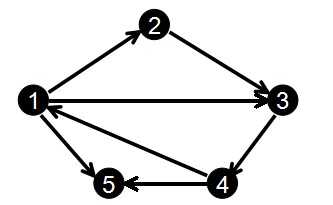前向星与链式前向星
Posted wkfvawl
tags:
篇首语:本文由小常识网(cha138.com)小编为大家整理,主要介绍了前向星与链式前向星相关的知识,希望对你有一定的参考价值。
这里借鉴了一些大佬的文章和代码,给出链接,谢谢
https://blog.csdn.net/ACdreamers/article/details/16902023
https://blog.csdn.net/wuhuajunbao/article/details/22589619
引言
一般来讲,图的常用存储结构有邻接矩阵,和邻接表,但我们知道邻接矩阵是好写但效率低,邻接表虽效率高但不好写,今天来讲一下图的另一只常用的存储结构:前向星和链式前向星,介于上述两种存储结构之间的一种比较中庸的存储结构——前向星。前向星固然好些,但效率依旧并不高。而在优化为链式前向星后,效率也得到了较大的提升。虽然说,世界上对链式前向星的使用并不是很广泛,但在不愿意写复杂的邻接表的情况下,链式前向星也是一个很优秀的数据结构。
首先我们来说一下图的前向星表示方法:
1.前向星
前向星是一种通过存储边信息的方式来存储图的一种数据结构,他构造简单,读入每条边的信息,将边存放在数组中,把数组中的边按照起点顺序排列,前向星也就构造完成了。方便查询,我们用另外一个数组用head[i]记录以i为边集在数组中的第一个存储位置.
如图:

我们输入边的顺序为:
1 2
2 3
3 4
1 3
4 1
1 5
4 5
那么排完序后就得到:
编号: 1 2 3 4 5 6 7
起点u: 1 1 1 2 3 4 4
终点v: 2 3 5 3 4 1 5
得到:
head[1] = 1
head[2] = 4
head[3] = 5
head[4] = 6
存储结构:
struct node { int from;///起点 int to;///终点 int w;///权值 } edge[maxm]; int head[maxn];
比较函数:
bool cmp(node a,node b) { if(a.from == b.from && a.to == b.to) return a.w < b.w; if(a.from == b.from) return a.to < b.to; return a.from < b.from; }
读入数据:
void input() { for(int i = 0; i < m; i ++) { scanf("%d%d%d",&edge[i].from,&edge[i].to,&edge[i].w); } memset(head ,-1 ,sizeof(head)); sort(edge , edge + m , cmp); head[edge[0].from] = 0; for(int i = 1; i < m; i ++) { if(edge[i].from != edge[i-1].from) { head[edge[i].from] = i; //确定起点为vi的第一条边的位置。 } } }
遍历数据:
void output() { for(int i = 1; i <= n; i ++) cout << "head["<<i<<"]: "<<head[i]<<endl; cout << "遍历所有的边"<<endl; for(int i = 1; i <= n; i ++) //head[i]的下标i等于vi; { for(int j = head[i]; edge[i].from == i && j < m; j ++) { cout << edge[j].from << " " << edge[j].to << " " << edge[j].w <<endl; } } }
完整代码:
1 #include <iostream> 2 #include <algorithm> 3 #include <cstdio> 4 #include <cstring> 5 using namespace std; 6 const int maxn = 1000; 7 const int maxm = 1000000; 8 struct node 9 { 10 int from;///起点 11 int to;///终点 12 int w;///权值 13 } edge[maxm]; 14 int head[maxn]; 15 int n,m ; 16 bool cmp(node a,node b) 17 { 18 if(a.from == b.from && a.to == b.to) return a.w < b.w; 19 if(a.from == b.from) return a.to < b.to; 20 return a.from < b.from; 21 } 22 void input() 23 { 24 for(int i = 0; i < m; i ++) 25 { 26 scanf("%d%d%d",&edge[i].from,&edge[i].to,&edge[i].w); 27 } 28 memset(head ,-1 ,sizeof(head)); 29 sort(edge , edge + m , cmp); 30 head[edge[0].from] = 0; 31 for(int i = 1; i < m; i ++) 32 { 33 if(edge[i].from != edge[i-1].from) 34 { 35 head[edge[i].from] = i; //确定起点为vi的第一条边的位置。 36 } 37 } 38 } 39 40 void output() 41 { 42 for(int i = 1; i <= n; i ++) 43 cout << "head["<<i<<"]: "<<head[i]<<endl; 44 cout << "遍历所有的边"<<endl; 45 for(int i = 1; i <= n; i ++) //head[i]的下标i等于vi; 46 { 47 for(int j = head[i]; edge[i].from == i && j < m; j ++) 48 { 49 cout << edge[j].from << " " << edge[j].to << " " << edge[j].w <<endl; 50 } 51 } 52 } 53 int main() 54 { 55 while(scanf("%d%d",&n , &m)!=EOF) 56 { 57 input(); 58 output(); 59 } 60 return 0; 61 }
可以看出,前向星构造时间的复杂度主要取决于排序函数,一般来说,时间复杂度为O(m logm);空间上需要两个数组,故空间复杂度为O(m+n);前向星的有点在于可以对应点非常多的情况,可以存储重复边,但不能直接判断图中任意两点是有边。
2.链式前向星
建立存储结构:
struct EDGE{ int next; //下一条边的存储下标 int to; //这条边的终点 int w; //权值 }edge[MAXM];
另外还有一个数组head[],它是用来表示以i为起点的第一条边存储的位置,实际上你会发现这里的第一条边存储的位置其实在以i为起点的所有边的最后输入的那个编号.
int head[MAXN]; //head[i]表示以i为起点的第一条边
head[]数组一般初始化为-1,对于加边的add函数是这样的:
void add(int u,int v,int w) { edge[cnt].w = w; edge[cnt].to = v; edge[cnt].next = head[u]; head[u] = cnt++; }
初始化cnt = 0,这样,现在我们还是按照上面的图和输入来模拟一下:

edge[0].to = 2; edge[0].next = -1; head[1] = 0;
edge[1].to = 3; edge[1].next = -1; head[2] = 1;
edge[2].to = 4; edge[2],next = -1; head[3] = 2;
edge[3].to = 3; edge[3].next = 0; head[1] = 3;
edge[4].to = 1; edge[4].next = -1; head[4] = 4;
edge[5].to = 5; edge[5].next = 3; head[1] = 5;
edge[6].to = 5; edge[6].next = 4; head[4] = 6;
很明显,head[i]保存的是以i为起点的所有边中编号最大的那个,而把这个当作顶点i的第一条起始边的位置.
这样在遍历时是倒着遍历的,也就是说与输入顺序是相反的,不过这样不影响结果的正确性.
比如以上图为例,以节点1为起点的边有3条,它们的编号分别是0,3,5 而head[1] = 5
遍历数据:
for(int i=head[st]; i!=0; i=edge[i].next) {///i开始为第一条边,每次指向下一条(以0为结束标志)若下标从0开始,next应初始化-1 cout << "Start: " << st << endl; cout << "End: " << edge[i].to << endl; cout << "W: " << edge[i].w << endl << endl; }
那么就是说先遍历编号为5的边,也就是head[1],然后就是edge[5].next,也就是编号3的边,然后继续edge[3].next,也就是编号0的边,可以看出是逆序的.
以上是关于前向星与链式前向星的主要内容,如果未能解决你的问题,请参考以下文章
